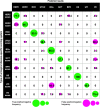Machine learning diagnosis by immunoglobulin N-glycan signatures for precision diagnosis of urological diseases
- PMID: 35524940
- PMCID: PMC9277255
- DOI: 10.1111/cas.15395
Machine learning diagnosis by immunoglobulin N-glycan signatures for precision diagnosis of urological diseases
Abstract
Early diagnosis of urological diseases is often difficult due to the lack of specific biomarkers. More powerful and less invasive biomarkers that can be used simultaneously to identify urological diseases could improve patient outcomes. The aim of this study was to evaluate a urological disease-specific scoring system established with a machine learning (ML) approach using Ig N-glycan signatures. Immunoglobulin N-glycan signatures were analyzed by capillary electrophoresis from 1312 serum subjects with hormone-sensitive prostate cancer (n = 234), castration-resistant prostate cancer (n = 94), renal cell carcinoma (n = 100), upper urinary tract urothelial cancer (n = 105), bladder cancer (n = 176), germ cell tumors (n = 73), benign prostatic hyperplasia (n = 95), urosepsis (n = 145), and urinary tract infection (n = 21) as well as healthy volunteers (n = 269). Immunoglobulin N-glycan signature data were used in a supervised-ML model to establish a scoring system that gave the probability of the presence of a urological disease. Diagnostic performance was evaluated using the area under the receiver operating characteristic curve (AUC). The supervised-ML urologic disease-specific scores clearly discriminated the urological diseases (AUC 0.78-1.00) and found a distinct N-glycan pattern that contributed to detect each disease. Limitations included the retrospective and limited pathological information regarding urological diseases. The supervised-ML urological disease-specific scoring system based on Ig N-glycan signatures showed excellent diagnostic ability for nine urological diseases using a one-time serum collection and could be a promising approach for the diagnosis of urological diseases.
Keywords: biomarker; glycosylation; immunoglobulin; machine learning; urologic disease.
© 2022 The Authors. Cancer Science published by John Wiley & Sons Australia, Ltd on behalf of Japanese Cancer Association.
Figures







Similar articles
-
N-glycan signature of serum immunoglobulins as a diagnostic biomarker of urothelial carcinomas.Cancer Med. 2021 Feb;10(4):1297-1313. doi: 10.1002/cam4.3727. Epub 2021 Jan 16. Cancer Med. 2021. PMID: 33455069 Free PMC article.
-
Aberrant N-Glycosylation Profile of Serum Immunoglobulins is a Diagnostic Biomarker of Urothelial Carcinomas.Int J Mol Sci. 2017 Dec 6;18(12):2632. doi: 10.3390/ijms18122632. Int J Mol Sci. 2017. PMID: 29210993 Free PMC article.
-
Significance of Serum N-glycan Profiling as a Diagnostic Biomarker in Urothelial Carcinoma.Eur Urol Focus. 2018 Apr;4(3):405-411. doi: 10.1016/j.euf.2016.11.004. Epub 2016 Nov 22. Eur Urol Focus. 2018. PMID: 28753809
-
Current and future applications of machine and deep learning in urology: a review of the literature on urolithiasis, renal cell carcinoma, and bladder and prostate cancer.World J Urol. 2020 Oct;38(10):2329-2347. doi: 10.1007/s00345-019-03000-5. Epub 2019 Nov 5. World J Urol. 2020. PMID: 31691082 Review.
-
Incidence of urological cancers in neurological patients: a review of the literature from the EAU Young Academic Urologist Functional Group.Minerva Urol Nephrol. 2023 Apr;75(2):163-171. doi: 10.23736/S2724-6051.23.05127-3. Minerva Urol Nephrol. 2023. PMID: 36999836 Review.
Cited by
-
AI for BPH Surgical Decision-Making: Cost Effectiveness and Outcomes.Curr Urol Rep. 2024 Sep 23;26(1):4. doi: 10.1007/s11934-024-01240-6. Curr Urol Rep. 2024. PMID: 39312102 Review.
-
The Association Between Neonatal Respiratory Distress Syndrome and Plasma IgG N-Glycosylation: A Case-Control Study.J Inflamm Res. 2025 May 21;18:6439-6451. doi: 10.2147/JIR.S524188. eCollection 2025. J Inflamm Res. 2025. PMID: 40416708 Free PMC article.
-
Artificial Intelligence and Novel Technologies for the Diagnosis of Upper Tract Urothelial Carcinoma.Medicina (Kaunas). 2025 May 20;61(5):923. doi: 10.3390/medicina61050923. Medicina (Kaunas). 2025. PMID: 40428881 Free PMC article. Review.
-
Constructing a signature based on the SIRT family to help the prognosis and treatment sensitivity in glioma patients.Front Genet. 2022 Dec 9;13:1035368. doi: 10.3389/fgene.2022.1035368. eCollection 2022. Front Genet. 2022. PMID: 36568393 Free PMC article.
-
IgG N-glycan Signatures as Potential Diagnostic and Prognostic Biomarkers.Diagnostics (Basel). 2023 Mar 7;13(6):1016. doi: 10.3390/diagnostics13061016. Diagnostics (Basel). 2023. PMID: 36980324 Free PMC article. Review.
References
-
- Hatakeyama S, Amano M, Tobisawa Y, et al. Serum N‐glycan alteration associated with renal cell carcinoma detected by high throughput glycan analysis. J Urol. 2014;191:805‐813. - PubMed
MeSH terms
Substances
Grants and funding
LinkOut - more resources
Full Text Sources
Medical

